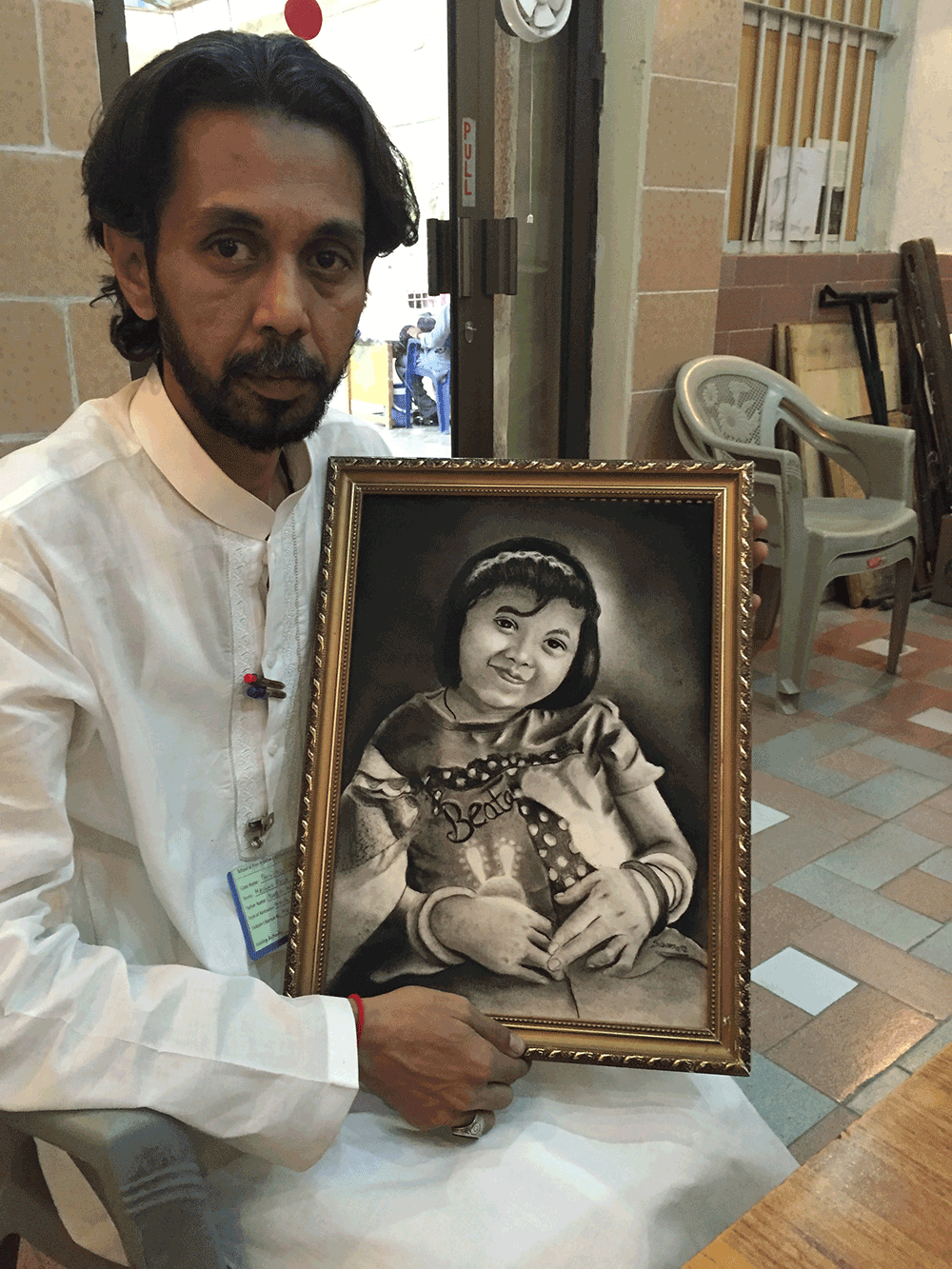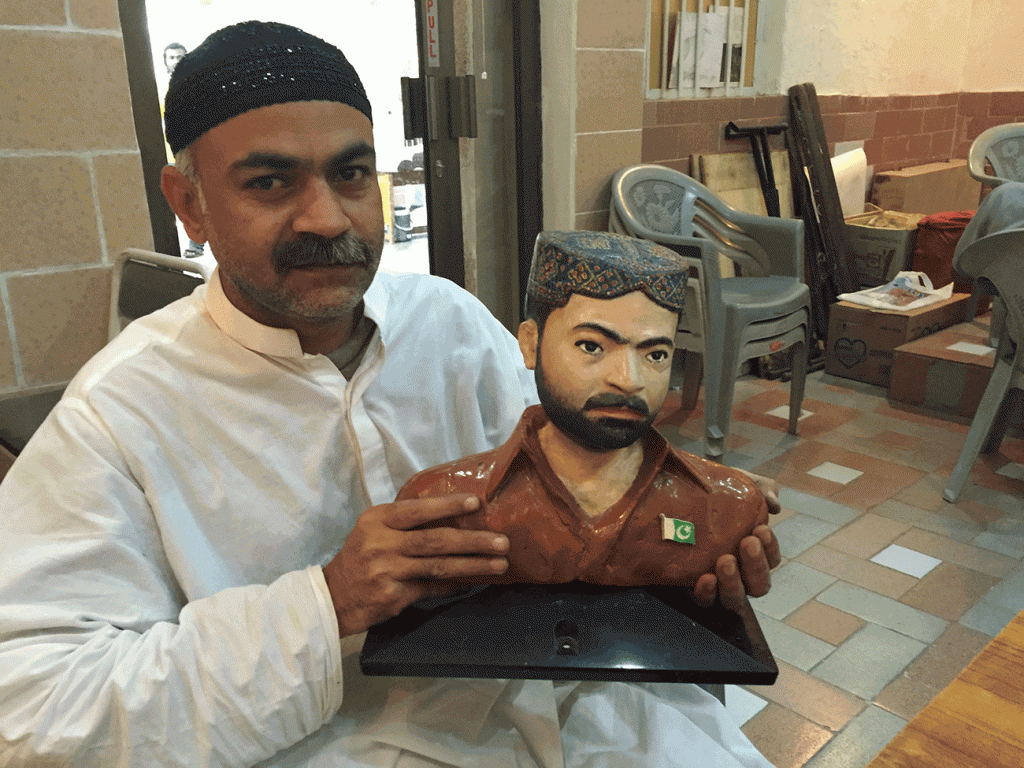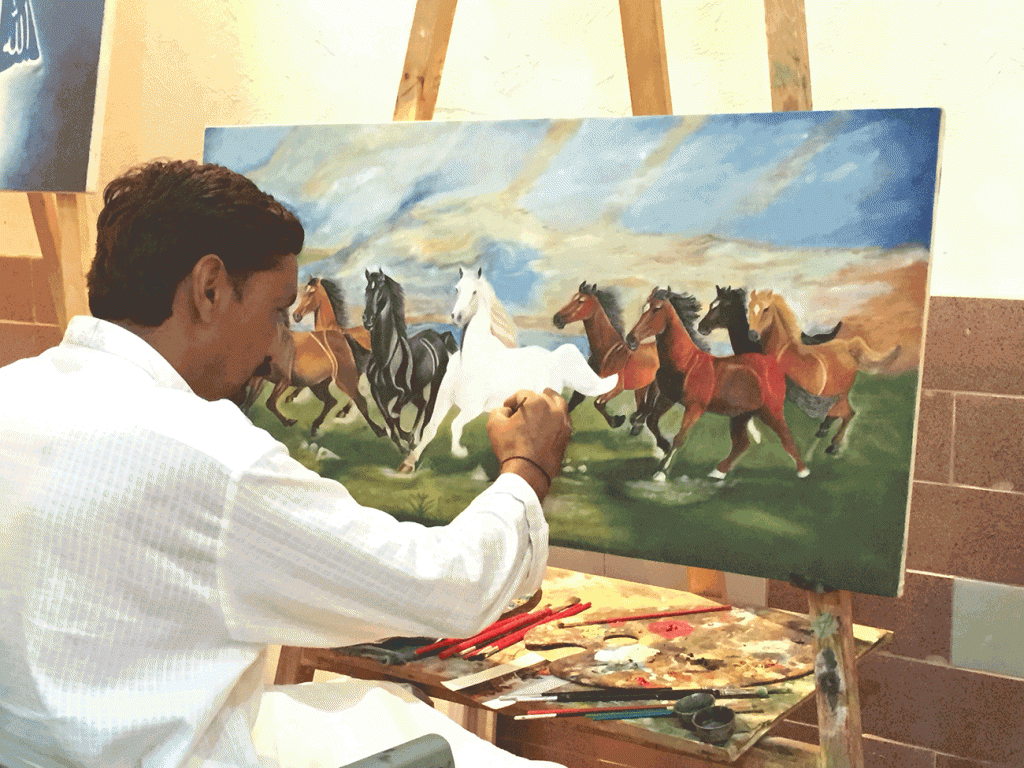Art in Chains: Art classes in Karachi prisons
By Mina Sohail | Special Report | Published 8 years ago
It is a reasonably spacious room, peppered with paintings resting on wooden easels. Men hold palettes, brushes and paints and work on the canvas facing them, creating images of galloping horses, scenic landscapes and silhouettes of women.
Inside the art room of Karachi’s Central Jail, the paintings are as rich in colour and form as are dark and dismal the stories behind the artists.
In a crisp white kurta and a traditional topi, Abdul Aziz Bugti holds a sculpture of himself with Pakistan’s flag glued on to the bust. Bugti was incarcerated in 2005 on charges of planning and planting explosives at the PIDC building in Karachi. He was subsequently awarded four death sentences.
“I used to be Nawab Akbar Khan Bugti’s driver,” he states. “One day while leaving Karachi for my village in Dera Bugti, I was caught by the police and brought here. I still don’t know why. I hadn’t committed any crime.”
Having joined the prison’s art classes five years ago, Bugti says he finds painting peaceful. “People from my village like these kinds of sculptures so I decided to make one of myself. When I paint, I like to introduce some Baloch elements into my work.” Bugti’s oil on canvas paintings, in fact, often depict rural Baloch women.
Two of Bugti’s brothers are also with him in prison. As he does not have any children and his parents have passed away, his only visitors are his nephews and nieces. When they come, he says he shows them his work.
“I have made Rs. 45,000 this year through the sale of my paintings in different galleries in the city. In fact, even the jail superintendent bought two paintings from me,” says Bugti.
Art classes are held in jail five days a week by art instructor Sikander Jogi. He has a total of about 100 students who are divided in two rooms as one room cannot accommodate so many inmates. “On average, the paintings are sold for Rs. 10,000,” Jogi divulges. “Most galleries determine the price of a painting based on the craft.”
Jogi adds, “Most people here are under trial. I do not interrogate them about their past or what crime they committed. For me they are just students who want to learn about art. I engage them in discussions on famous artists, and we look at books for inspiration. What they did before coming here does not concern me.”
Jogi says that IG Sindh Nusrat Mangan, an art lover himself, initiated this programme. “Coincidentally, the superintendent of the Central Prison, Qazi Nazeer Ahmed, is fond of art as well so they made a good team,” he states.
Jogi introduces Hasnain Raza, 37, who was brought to the Central Jail in 2013. He has been awarded a sentence of life imprisonment for kidnapping for ransom and murder. Before being imprisoned, Raza led a regular life. He did his B.Com from Jinnah Government College in Karachi, worked full time in a company as a computer graphics artist and got married. He talks about his daughter, Taskeen Fatima, whom he misses a great deal. Raza pulls out a painting of a little girl. It is a portrait of his daughter made by a colleague who saw Taskeen’s photograph and decided to paint it for his fellow inmate. “My daughter does come to visit me alongside my wife, but through this painting I can see her all the time,” he says with a sad smile.
“My case was complicated and for a long time I was under extreme stress; at times I felt like I was completely lost. Art has helped me cope,” Raza discloses.
Samar Abbas, 33, saunters inside the art room. Jogi says he was brought to prison because his relatives accused him of killing his wife, a first cousin, after five months of marriage. He is now serving a 25-year sentence.
“My family does not send me any photos of themselves. No one in my family has ever been in jail for any crime, and they are afraid to even share their pictures with me,” says Abbas. That is why he decided to paint a face that was familiar to him before being imprisoned: that of the Mona Lisa.
“I have done my matric and was in the real estate business before being jailed. One day I saw an art class in progress and liked it. So I decided to enrol,” says Abbas.
Depicting culture seems to be a popular theme at the Central Jail. Raza displays a painting by him portraying a woman in Thar. It is reflective of his Sindhi roots and also of his yearning for the land he belongs to.
In the last few years, he has made several paintings depicting Thari women, along with landscapes of the area. But he also creates Eid cards for his daughter.
Superintendent Qazi Nazeer Ahmed and Jogi both give the IG, Mangan, complete credit for the jail’s art programme. “I have simply carried on what he started,” says Ahmed.
 He says he often goes to Saddar to purchase art books at discounted prices for the prison’s art students. “The material for one painting costs these men about Rs. 1000-1500. Since most of them manage to sell their artwork, they are usually able to pay for the material themselves,” says Ahmed, who has purchased work by these artists and sent it to relatives abroad.
He says he often goes to Saddar to purchase art books at discounted prices for the prison’s art students. “The material for one painting costs these men about Rs. 1000-1500. Since most of them manage to sell their artwork, they are usually able to pay for the material themselves,” says Ahmed, who has purchased work by these artists and sent it to relatives abroad.
“People in art galleries and those buying the paintings understand the psyche of the inmates and are sympathetic. However, if 100 per cent of the prison population could be included in some form of a reformative program, that would be really beneficial,” says Ahmed. But a lack of funds and space to run different programmes makes that difficult.
On May 10, an exhibition held in the national museum of Pakistan to acknowledge artists from Sindh, showcased works by those who practice art in the Central Prison. Aziz Bugti’s work, along with many others’ was showcased. Previously their work has also been exhibited at the Artchowk Gallery, the Alliance Francais and the Avari Hotel.
Clearly, art knows no bars.



